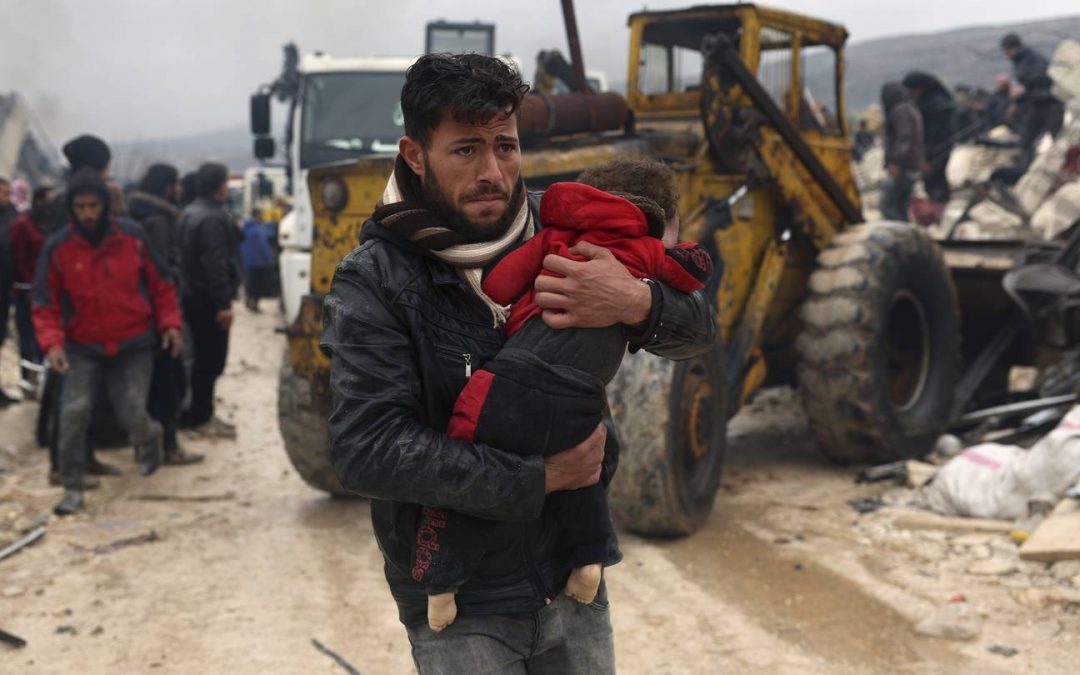The ground shook violently on Monday morning, sending shockwaves of fear and destruction through Turkey and Syria. A 7.8 magnitude earthquake rocked the region, leaving behind a devastating toll of more than 2,300 dead and thousands more injured.
The quake was centered in Turkey’s southeastern province of Kahramanmaras, but the effects were felt as far away as Cairo and Beirut. Buildings crumbled and homes collapsed, trapping residents beneath mounds of rubble. In the rebel-held enclave of Syria, the area affected is divided between government-held territory and the country’s last opposition-held enclave, which is surrounded by Russian-backed government forces.
The quake piled more misery on a region already beset by a decade of civil war and a refugee crisis. Strained health facilities and hospitals quickly filled with injured, rescue workers said. Others had to be emptied, including a maternity hospital, according to the SAMS medical organization.
The region sits on top of major fault lines and is frequently shaken by earthquakes. Some 18,000 were killed in similarly powerful earthquakes that hit northwest Turkey in 1999. Thousands of buildings were reported collapsed in a wide area extending from Syria’s cities of Aleppo and Hama to Turkey’s Diyarbakir, more than 330 kilometers (200 miles) to the northeast.
Offers of help — from search-and-rescue teams to medical supplies and money — poured in from dozens of countries, as well as the European Union and NATO. The vast majority were for Turkey, with Russian and even an Israeli promise of help to the Syrian government, but it was not clear if any would go to the devastated rebel-held pocket in the northwest.
In Turkey, people trying to leave the quake-stricken regions caused traffic jams, hampering efforts of emergency teams. Mosques around the region were opened to provide shelter for people unable to return to damaged homes amid temperatures that hovered around freezing. Televisions stations in Turkey aired screens split into four or five, showing live coverage from rescue efforts in the worst-hit provinces.
The tragedy of the earthquake in Turkey and Syria is heartbreaking. As the death toll rises and rescue efforts continue, the world watches in horror at the destruction and suffering of the region. With millions of refugees from the civil war and a region already beset by poverty, the quake has only added to the misery.
The US Geological Survey measured the pre-dawn quake at 7.8, with a depth of 18 kilometers (11 miles). Hours later, a 7.5 magnitude one struck more than 100 kilometers (60 miles) away. The second jolt in the afternoon caused a multi-story apartment to topple face-forward onto the street in the Turkish city of Sanliurfa, smashing into rubble and raising a cloud of dust as bystanders screamed.
The quake has caused some damage to the Crusader-built Marqab, or Watchtower Castle, on a hill overlooking the Mediterranean. Part of a tower and parts of some walls collapsed. In Turkey, the quake damaged a historic castle perched atop a hill in the center of the provincial capital of Gaziantep, about 33 kilometers (20 miles) from the epicenter. Parts of the fortresses’ walls and watch towers were leveled and other parts heavily damaged.
More than 1,500 people were killed in 10 Turkish provinces, with some 9,700 injured, according to Turkish authorities. The death toll in government-held areas of Syria climbed to over 460 people, with some 1,300 injured, according to the Health Ministry. In the country’s rebel-held northwest, groups that operate there said the death toll was at least 380, with many hundreds injured.
The tragedy of the earthquake in Turkey and Syria is immense. Rescuers are working tirelessly to search for survivors, and the world has come together to offer support and aid. As the death toll rises, it is a reminder of the fragility of life and the power of nature.
Source: www.wftv.com
